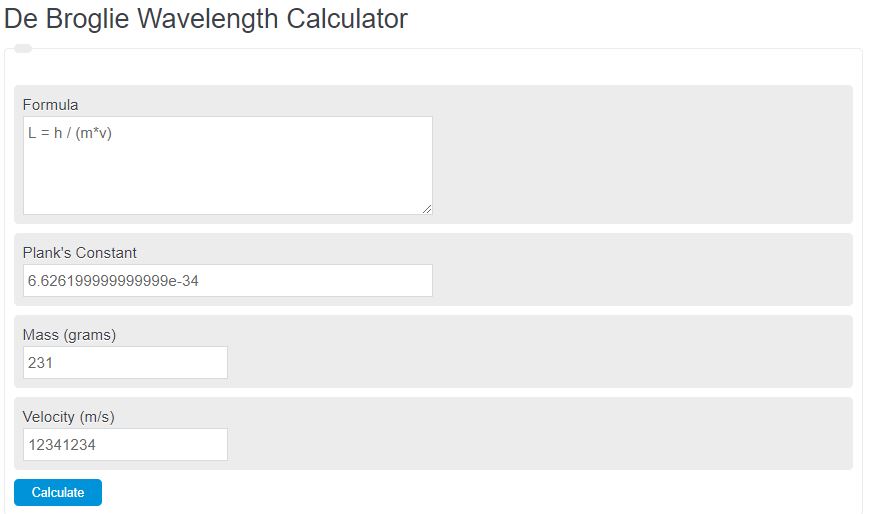Enter the mass, velocity, and plank’s constant into the calculator to calculate the De Broglie Wavelength.
- Wavelength Calculator
- Wave Speed Calculator
- Speed of Sound Calculator
- Nanometers to Joules Calculator
- Peak Wavelength (Wien’s Law) Calculator
- Group Delay Dispersion Calculator
De Broglie Wavelength Formula
The following equation is used to calculate a de broglie wavelength.
L = h / (m*v)
- Where L is the wavelength
- h is Plank’s constant (6.6262 X 10 & -34 Js)
- m is the mass (grams)
- v is the velocity (m/s)
To calculate the wavelength from De Broglie’s formula, divide Plank’s constant by the product of the mass and velocity.
De Broglie Wavelength Definition
A De Brolie wavelength is a law that states all matter exhibits wave-like behavior, and therefore you can calculate the wavelength using the equation.
De Broglie Wavelength Example
How to calculate De Broglie Wavelength?
- First, determine the mass.
Measure the mass of the object or material.
- Next, determine the velocity.
Calculate the velocity of the matter.
- Finally, calculate the De Broglie Wavelength.
Calculate the wavelength using the formula above.
FAQ
What is the de Broglie wavelength equation?
The de Broglie wavelength equation is (lambda = frac{h}{mv}), where (lambda) is the wavelength, (h) is Planck’s constant, (m) is the mass of the particle, and (v) is the velocity of the particle. This equation describes the wave-particle duality of matter, suggesting that every object has wave-like properties.
How does the de Broglie wavelength apply to everyday objects?
While the de Broglie wavelength is a fundamental concept in quantum mechanics, its effects are most noticeable in particles at the atomic or subatomic level due to their extremely small mass. For everyday objects, which have a much larger mass, the wavelength is so short that wave-like properties cannot be observed.
Can the de Broglie wavelength be observed directly?
Direct observation of the de Broglie wavelength is challenging and typically requires sophisticated experimental setups, such as electron microscopes or double-slit experiments with particles. These setups allow scientists to observe interference patterns that result from the wave-like behavior of particles, indirectly indicating the presence of a de Broglie wavelength.

